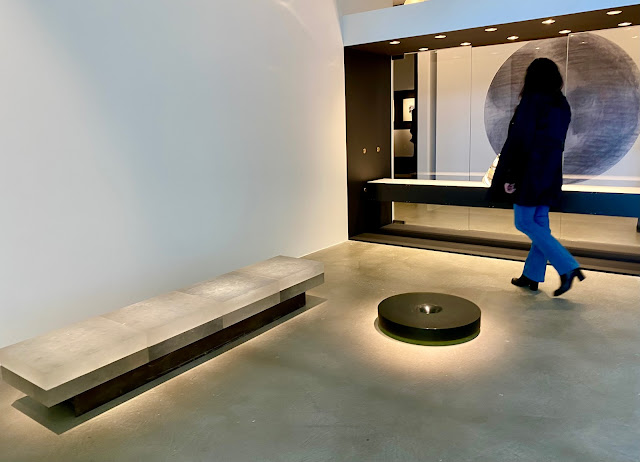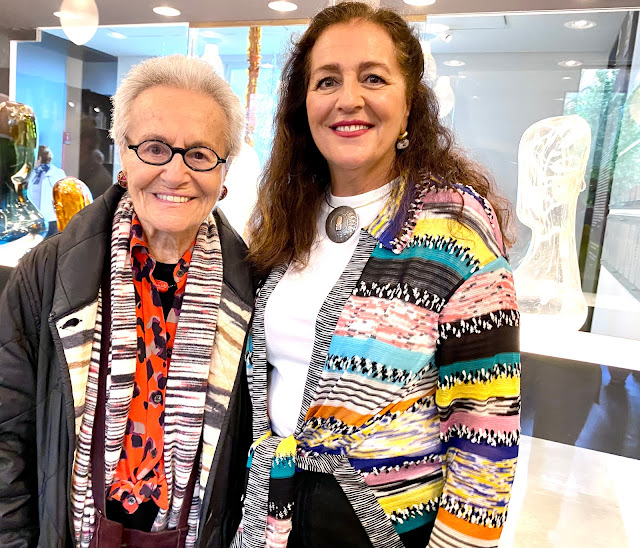Le Stanze del Vetro
Bohemian Glass: The Great Masters
Exhibition and Party Photos
At Le Stanze del Vetro on the island of San Giorgio Maggiore the exhibition - Bohemian Glass: The Great
Masters - curated by Caterina Tognon and Sylva Petrova - until November 26 - is organized in collaboration with the Museum of Decorative Arts in Prague
and recounts the emancipation of Bohemian glass from its traditional categorization as
applied and decorative art, as well as its use in the creation of influential abstract sculptural works in Bohemia after the Second World War.
Vaclav Cigler - Square with Spiral - 1970s
Curators Caterina Tognon and Sylva Petrova with David Landau
The exhibition features the works of six leading major artists of contemporary glass sculpture, leading figures in the Czech
glassmaking scene who lived through turbulent societal upheavals because they had been
born in the Czech lands in the 1920s and 1930s. These artists endured the largest-ever military conflict in Europe, followed by a brief respite of freedom and democracy, only to be
plunged into totalitarian domination in 1948, which they could finally shed to return to standards of European democracy after 1989. It is remarkable that, despite all the negative effects
caused by the absence of freedom and prosperity, they managed to overcome these challenges and grow their art in the broader context of the development of certain artistic disciplines in erstwhile Czechoslovakia. These were artists who initiated and nurtured a relatively
“new” mode of glassmaking, “artistic glass” which was not intended for mass production.
The works they created were unique, as in the case of traditional artistic disciplines such as
sculpting or painting, while drawing on the specific characteristics of glass.
Vaclav Cigler with Michal Motycka - Golden Raft - 2007
Vaclav Cigler - Sphere - Rainbow Egg - 2019
Vaclav Cigler
Bench - 2001 - Spring - 1992
The exhibition presents the late-1960s designs of visionary installations and architecture and, even more, sophisticated optic crystal artworks of great impact in terms of purity and minimalism of Vaclav Cigler - Vsetiin 1929.
Vaclav Cigler - Blue Pyramid - 2020
Alessandra and Alessandro Zoppi with Alvise Orsini
"Water stopped, to please the human eye. The substance is crystal clear and has become synonymous with purity."
Rene Roubicek - Prague 1922-2018 - Miluse Roubickova - Prague 1922-2015 - whose work is also on show - are two artists who were a couple in their private life, yet independent in their artistic output. Roubicek’s - above - abstract glass pieces are an expression of vitality and serenity, but at the same time they portray the contemporary creative way with which the artist faced a painful and difficult life during the years of the Communist regime.
Promenade - Pinacotheca Series - 2003
Photo Enrico Fiorese - Private collection - Venice - Multicolor hand-blown glass
Courtesy Le Stanze del vetro
Rene Roubicek - Little Cosmos - 1960s
Rene Roubicek - Columns -1964-1967 - Untitled - 1990s
"The values of existence largely consists in how fervently we are able to live them. The value of our human life is dependent on the values within us. People create their own human world. It holds that which we put in it."
A characteristic narrative trait of Miluse Roubickova’s production is a representation of the female world that is far ahead of its time: through bouquets of flowers, trays of pastries, balls of coloured wool and jam jars, all rigorously made of glass, she represents all the women and their specific domestic world.
Miluse Roubickova - Blossoms - Blue -1991 - Amber - 1970s
Yellow and Red Bouquet - 1991
"Glass exists in various forms. Its dominant qualities are transparency, brilliance, radiance. It is richly extravagant. A hot material, like glowing lava. But glass can also be seen as mysterious, intimate, as the profound contemplation of a simple shape. Or these are moments when we suppress the qualities of glass almost entirely and transform it into a force that expands into excessive experience, into expression, into enigmatic explosive spheres..."
The works by Vladimír Kopecky - Svojanov 1931 - are strongly performative and site-specific pieces. He is well known for his use of transparent industrial glass as a “canvas” for abstract paintings of great chromatic breadth.
Vladimir Kopecky - Desire - 2021
"The twentieth century ended, and this fact forced us to analyze what was in the past, where we succeeded and where we failed. This is why it is very important for every detail of these historic Czech endeavors in the field of modern glass to be recorded and assessed..."
Special attention is devoted to the couple Stanislav Libensky - Sezemice 1921-2002 and Jaroslava Brychtova - Zelezny Brod 1924–2020 - who from the 1940s dedicated themselves to research and experimentation with glass casting or open-mould casting. Significantly, the casting method was to become synonymous with modern Czechoslovakian glass. For over sixty years, they investigated its technical possibilities and came up with works that were majestic in size, as well as remarkable in their purity of colour and transparency.
Stanislav Libensky - Jaroslava Brychtova - Installation
Stanislav Libensky - Jaroslava Brychtova - Lying Angel - 1999-1920
Jean Blanchaert
The show closes with photographs by Josef Sudek - Kolin 1896–1976 - from the Glass Labyrinths series, taken within the exhibition Contemporary Bohemian Glass which was held in Prague in 1970 at the time of the 5th congress of the AIHV – the Association Internationale pour l’Histoire du Verre. By sharing his remarkable point of view, Sudek – often referred to as “the poet of Prague” – re-interprets the intrinsic relationship between glass and light in the works from this important, historic exhibition. Finally, the exhibition features five films produced between the 1980s and the present day, describing the unique creativity of the artists whose work is showcased.
Josef Sudek - Glass Labyrinths Series - Photographic Installation
Jean-Michel Ribettes
Rosella Zorzi
A delicious lunch was served in the Palladian cloisters of the
Fondazione Giorgio Cini
Camilla Purdon, Olinda Adeane, Ingrid and Mimi Todhunter












































